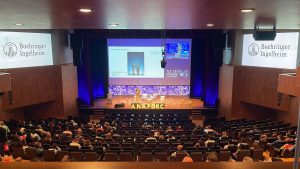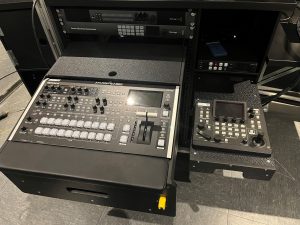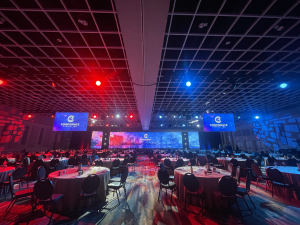- The need for livestreaming during the pandemic brought challenges and successes for the RCN.
- RCN's hybrid congress needed to facilitate live debating between members in a hall and members at home.
- For RCN's award ceremony, the VR-50HD sent live visual and audio feed via virtual camera to the session room for the candidates and the V-160HD sent an SDI video feed for the finalists.
In the evolving world of hybrid events, it’s difficult to deliver a seamless production live and online that meets the demands of the client and the expectations of the audience. The process tests even the toughest of AV teams. Finding the right streaming video switcher to use for hybrid events, that one product that can do it all, can itself be a challenge. This wasn’t the case for the AV engineers at the Royal College of Nursing. They knew they needed the new Roland V-160HD Streaming Video Switcher. And that nothing else would do.
Annual Congress
The V-160HD is not the first Roland product for the Royal College of Nursing (RCN). They have been using the Roland VR-50HD at the London HQ for several years and describe it as “an amazing piece of gear.” Before the pandemic and restrictions on live events, the RCN had a full program to deliver from their headquarters and venues around the UK. This includes its annual congress.
“We have a congress every year,” Senior AV Engineer at the RCN Gary Shanley explains. “Members join and they have a debate. As we are a trade union it’s a bit like a party-political debate, discussing subjects in a big arena. The last in-person congress was at the Liverpool Arena in 2020,” he shares. “Usually, we’d capture the live debate, stream it to our members’ area, record it for our archives. Sometimes one or two keynote speeches would go to Facebook. That’s how we would usually do it, but due to COVID we had to plan to do things very differently.”

A New Challenge
The definition of different in this case also meant dealing with a higher degree of complexity. This year’s hybrid congress needed to facilitate live debating between members in a hall and members at home.
“The issue we had was how would we bring in the people at home to join in the live debate and to talk live with people in the hall,” explains Shanley. “We looked at NDI Teams and that was okay. We’d used it before. But the problem with that was we’re using Hopin now (a virtual events platform). So you’re streaming to the main stage which is on a 30-second delay. If you go to Teams or Zoom as well, they start to clash over using camera and mic with the virtual platform.”
The are other considerations as well. “If someone has Teams or Zoom open, it doesn’t work, or they can’t get back into Hopin,” he says. “Someone suggested we use a session area in Hopin, so we were going to invite the members to go in there. Matt devised a queuing system linked to Hopin so that they would come in and join a session. We captured them full screen from the session area.”
This year’s hybrid congress needed to facilitate live debating between members in a hall and members at home.
The Plan Comes Together
The plan worked. “It’s a bit like a Zoom meeting in that you are able to full-size someone’s tile, mute everyone else’s audio, then capture them,” Shanley reveals. “We would then send that using the VR-50HD to the main room, using a virtual feed from the main stage in real-time into the actual session meeting.”
At the time, the RCN only had the VR-50HD. Still, they knew that they would need a second vision mixer to achieve the results needed. “Matt had noticed this amazing vision mixer, the V-160HD, and we got the go-ahead to buy it,” he says. “In the end, the congress event became completely virtual. But because we had practiced this setup, we were confident that we could do what we wanted with the VR-50HD and V-160HD. And more.” CVP supplied the V-160HD to the Royal College of Nursing.

A New Hurdle
Sure enough, the next challenge was around the corner: the prestigious Royal College of Nursing Awards Ceremony. The event took place in London hosted by TV presenter Kate Garraway and RCN General Secretary & Chief Executive Pat Cullen. Pre-pandemic, this would have been the Oscars of the nursing calendar. However, thanks to COVID restrictions, an in-person event was impossible.
Celebrating the successes of nursing staff across the UK was more important than ever. It was clear that the show had to go on in the most impressive way possible. Once again, the pressure was on Shanley and Radcliffe to produce, stream, and record the ceremony. They also had to recreate the feeling of the in-person events of previous years. This meant capturing the emotion of the audience, the nominees, and the winners.
Celebrating the successes of nursing staff across the UK was more important than ever. It was clear that the show had to go on in the most impressive way possible.
Matthew Radcliffe
“The RCN insisted that the finalists join a session room in real-time, to see the surprise on their faces,” Shanley says. “We told them how difficult that would be with 72 people and 16 categories. Normally for an event like that, you’d rehearse and produce in advance. With virtual events you have to test everyone involved, you have to make sure they know what they have to do and when.”
There were trepidations. “Some won’t read the instructions, so we were a bit worried about that, but we tested as many as we could beforehand. But I was confident, and Matt was confident that technically, now that we had the V-160HD, we could go ahead and do this.”
Showtime Arrives
Finally, the day of the event came. “When we streamed there is a delay, so bringing winners up from the main stage would take too long. So, we created a backroom or “session” for the finalists.” It was an inspired idea. “The idea was that on the day of each session, each category would come on, they’d be in the back end and share their camera,” Shanley says. ” I would then full screen the winner and send it to Kate Garraway, the presenter. Some of them disappeared on the night of the event. We had to try to find them while trying to operate everything and some of them got on.”
Indeed, the night was a challenge. “We knew it would be difficult, relying on other people’s skills and their internet connection, on a whole host of things. But it was quite a feat!”
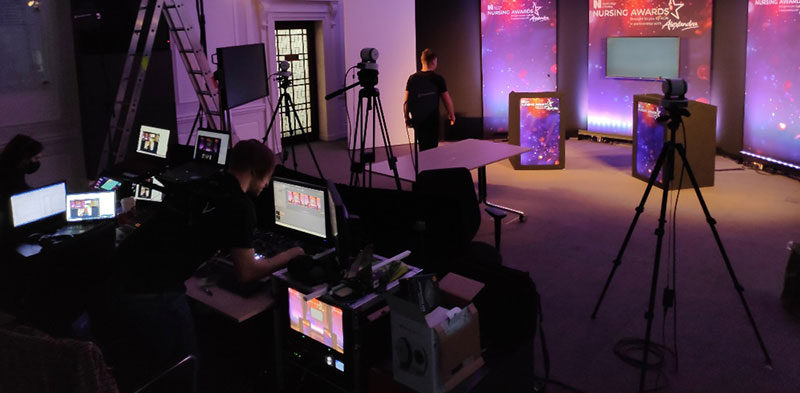
VR-50HD and V-160HD to the Rescue
The team also needed Kate Garraway to talk to the winners in real-time and using the session room this was possible. The VR-50HD sent the live vision and audio feed via virtual camera to the session room (via AUX) for the candidates while the V-160HD sent an SDI video feed for the finalists. An audio mix gets sent to the VR-50HD.
They sent the winners via PRG to the V-160HD. Using the “audio follows video” feature, audio was only shared when the finalist was live. Radcliffe oversaw operating the V-160HD on the night, feeding into Wirecast into the streaming computer. The V-160HD switched between three Birddog cameras, the VR-50HD for the winners, and a videographer feed for videos and slides. Another member of the RCN AV team, Rob Castro, oversaw the audio, sending a master mix of the audio to the V-160HD to send to Wirecast.
Summing up the situation, Radcliffe explains, “We found ourselves in a situation where the old equipment we use for streaming served us perfectly well. But we’ve moved into this new age of expectation to produce hybrid events which need more inputs and more outputs.”
There’s going to be a lot more communication between the people who are attending those events, so this piece of equipment lends itself to producing this kind of event.
Matthew Radcliffe
New Tools for New Demands
Ultimately, it’s a new era. “Not only are you streaming, but sending people that are calling in live on screens on stage,” he says. “You need more options on the inputs and the output. And also more options on how you can assign them. I saw the V-160HD and thought, ‘Wow, Roland has got ahead of the game here.’ They’ve produced a switcher that is going to work well for people like ourselves who are stepping into this new world where we are going to have to do a lot more than just stream the event.”
The benefits of the Roland gear extend beyond streaming. “There’s going to be a lot more communication between the people who are attending those events, so this piece of equipment lends itself to producing this kind of event.”
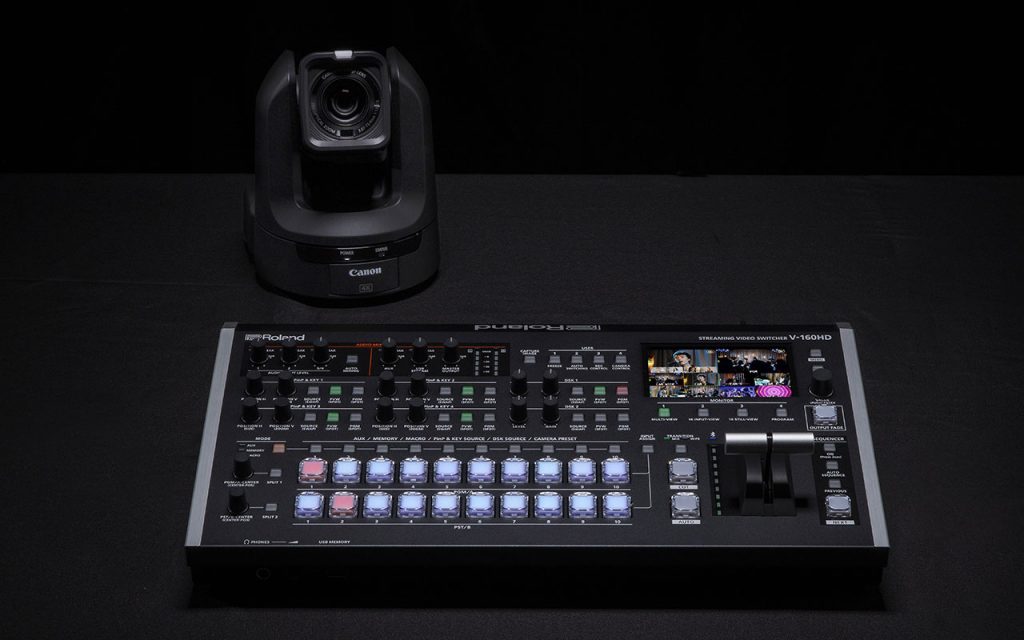
Added Benefits
“We had three outputs we were using: one output for the stream, one output for the screen that was on the stage, and another output for what was essentially a waiting room for the presenters,” he shares. “We initially used the PROG output (from the V-160HD) on our computer which has got a capture card in it. So, we didn’t use the USBC connection.” It was a lucky fluke. “However, I suddenly realized the benefit of the USBC because it frees up 3 outputs, but also the ability to stream from there as well.”
Radcliffe goes on to detail some other useful features. “The V-160HD allowed us to work with a whole host of things going on. We had the people calling in on Hopin, people on stage with the cameras, pre-recorded videos. All these were being sent to different locations. We were able to manage all those with the V-160HD which was great.”
Shifting Expectations
A high-end production, the awards ceremony would be a live event with music and celebrities streamed live. Yet in 2020, the ceremony had to be completely virtual. “Last year we did it on live events in Microsoft Teams and everything had to be pre-recorded and that was very hard,” Radcliffe recalls. “It lost the feeling. The presenters felt that they were talking to nobody and there was no feedback from the audience except in the comments tab,” he says.
“So that’s why this year, even though it’s still virtual they wanted to somehow bring the winners up. That was the nicest thing about it, when you see them in person, see their reaction. Otherwise, it’s just presenters and pre-recorded material,” Radcliffe stresses. “We couldn’t replace the live feeling, but what we could achieve with the V-160HD on board was the best that we could do.”
We had the people calling in on Hopin, people on stage with the cameras, pre-recorded videos. All these were being sent to different locations. We were able to manage all those with the V-160HD which was great.
Matthew Radcliffe
A Feel for the Event
The RCN is already treading new ground with the reach of its events program. “We did an event with 3000 people online; it was an event with the RCN and the Australian College of Nursing. It was live with nurses from UK and Australia. That’s one example of things that we couldn’t have done before. The flexibility that recording and streaming live events gives to the nursing profession is also important.”
“We’ll continue to do live events, but we can all see the potential, especially within our membership. With people who work long hours, can’t travel, and stay in hotels, you can now reach a much larger audience,” Radcliffe says. “The potential is there and it’s quite easy, with the V-160HD and the cameras we have now. We can make it all a bit more exciting as well. The cameras can move around, zoom in, capture the audience member asking the questions. Give the people at home a feel for the event.”
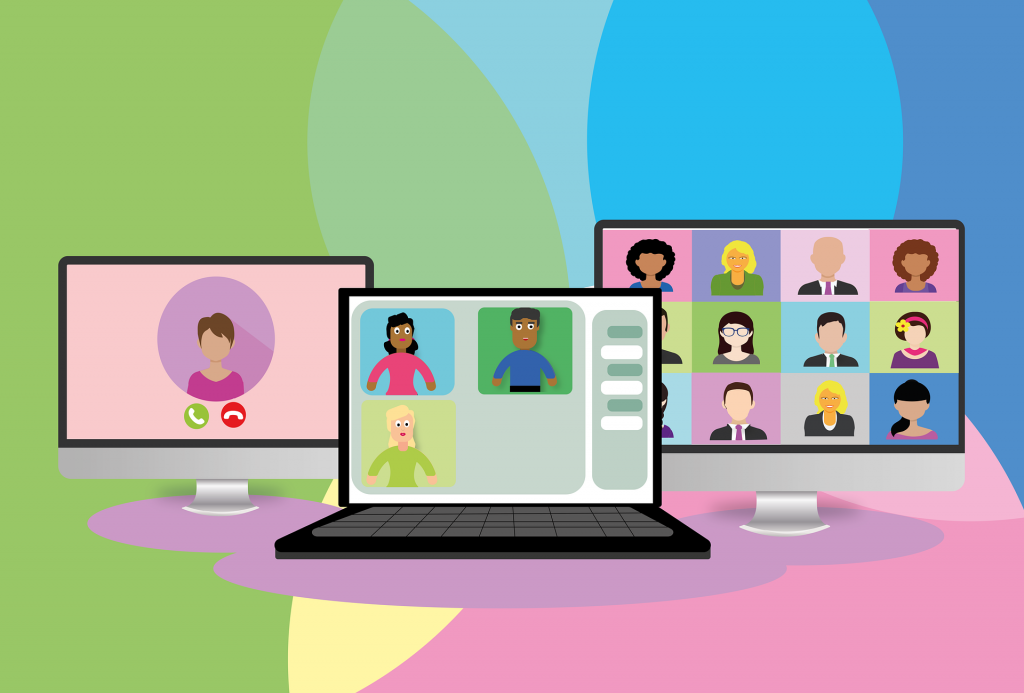
Webinars
As the interaction during live events develops, more benefits become apparent for the organizers as well. “One of the biggest things for me is before you’d only ever hear the person with the microphone asking the questions,” he laments. “With virtual events, all the keyboard warriors come out and start typing what they think. That’s great for the organizers because good or bad, they get to know what people are thinking. It can be very engaging if people can chat. So we can see a future where people at home are engaging in chat but also people in the venue could be engaging in chat on their phones.”
There are still necessary steps but the technology is there. “The platforms aren’t quite there yet, but I can see that in the future people at home will be able to engage with people in the audience. I think it’s going to be a very exciting time for people in our line of work. The events will look more interesting and the V-160HD just empowers us to do so much more with our events.”
The flexibility that recording and streaming live events gives to the nursing profession is important.
Matthew Radcliffe
A Changing Look and Feel
There’s no doubt that the expectation from the audience of how a virtual event should look and feel is higher than pre-pandemic. “People have got used to a certain way of working,” explains Radcliffe. “They join a Teams meeting and they can do everything. They can share content, talk to each other, see everyone. So now people expect and want to bring that experience into an event.”
How to meet these expectations is already in discussion within the RCN, making sure they have the technical capability to adapt. “With Hopin as a virtual event platform, they have a main stage and break-out rooms that they call sessions. I can see that translating into a real-world situation. Here at RCN HQ, we have a big hall where the main stage is. However, for some of our events, we have breakout rooms,” Radcliffe explains. “We have put in BirdDog NDI cameras in some of the rooms. But I can see us going into those rooms virtually as well and those breakout rooms will become the sessions.”

Other Uses
Alongside major events like the Awards Ceremony, the feature sets of the VR-50HD and V-160HD are invaluable at the RCN. They elevate the quality and functionality of meetings and webinars on Zoom or Teams.
“The streaming output on the VR-50HD with the virtual camera is also important,” he says. “So, here’s what I’d be doing on the V-160HD if we are doing a Zoom call. I’d be taking the cameras from the room and feeding them through the virtual camera to a laptop on Zoom. Not streaming but doing a Zoom webinar.”
This provides an improved experience. “Then the people in the webinar can see everything. The person on the stage, the person asking the questions, the audience, all through the virtual camera. And the audio is coming through that as well, so you can do a kind of audio mix,” he enthuses. “What you can do with the V-160HD is use split-screen. That allows for seeing the chat as well in the meeting. So not only can you do an interesting mix for the people at home, but you can also do a feed for people in the room.” This factor levels the playing field. “That’s important because a lot of people prefer to use Zoom or Teams, might not have the budget for a dedicated platform. So, if you have people coming in who want to connect on a Zoom then the virtual camera is fantastic.”
On the Road
The team isn’t relegated to one area either. “We do events all over the country so if one of our team has an event and hires a venue we can roll up with the V-160HD. It’s so compact. We can take the PPT slides from the AV guy at the venue, take a sound feed, mix that into a stream–make it look good. Rather than taking one feed, it’s versatile. It’s not going to be in one room for us, it’s going to be all over the building, even in other venues. You can take the V-160HD anywhere and it empowers you to do so much.”
Some days we’re using it as more of a traditional switcher with laptops for presentations. One another day, it's multiple camera setups for a livestream and it works very easily.
Matthew Radcliffe
A Wealth of Applications
Radcliffe adds, “The V-160HD enables you to do such a wide variety of things. Some days we’re using it as more of a traditional switcher with laptops for presentations. One another day, it’s multiple camera setups for a livestream and it works very easily.” It stands out from the pack. “In some other video style products, you need to have the frame rates matching and the resolutions matching. With Roland, you’re using it for all these different types of things.” It comes down to usability. “You can plug in and go. That makes life simple. Same for the VR-50HD.”
“It’s also useful when you’re using a virtual camera through Zoom or Teams. The audio factor gets sorted out because you have the AUX audio feed or AUX video feed,” he explains. “Don’t get all that clashing stuff that happens so the people in the session just hear what they need to hear and that makes that kind of stuff easy. Then any problems that arise are out of our hands.”
More to Learn
Both Shanley and Radcliffe admit they want to dive into the other features and start using the V-160HD to its full potential. Although it seems that will have to occur on the job.
“I’m laughing because we never have time to do anything, the first time we used the V-160HD we just had to turn it on and get going. But that’s what’s great about it; you can work it out very quickly,” Shanley comments. “The essential features are there to hand straight away. You can figure it out along the way.”
Describing when they first received the V-160HD, Radcliffe shares, “For me at first I thought, ‘No touchscreen? Is this going to be a problem?’ But as soon as I went into the menu, I saw that everything I needed was there. One menu and you can do anything.”
It opens up a whole new world for people like us on this level. The V-160HD is up another level, there’s so much more you can do with it."
Matthew Radcliffe
The Next Level
From there, things got even better. “I realized that you could assign things just using the hands-on buttons. But if you get confused you can just refer to the main menu and start assigning things however you need to.” The unit simply made sense. “Again, that makes it intuitive, you can do what you need to without assigning things.” Other features add to the convenience. The V-160HD also has an app that turns an iPad into a touchscreen interface. This provides faster access to and a better overview of the settings and parameters.
The pair enthuse about the price and what it means for events now and in the future. “You can make amazing-looking events. It opens up a whole new world for people like us on this level. The V-160HD is up another level, there’s so much more you can do with it.”


